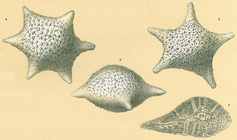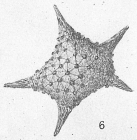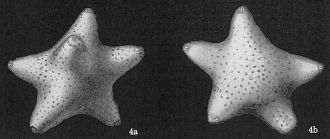Foraminifera taxon details
Baculogypsina Sacco, 1893
484701 (urn:lsid:marinespecies.org:taxname:484701)
accepted
Genus
Orbitolina concava var. sphaerulata Parker & Jones, 1860 accepted as Baculogypsina sphaerulata (Parker & Jones, 1860) (type by monotypy)
- Species Baculogypsina bonarellii Osimo, 1908 †
- Species Baculogypsina gallowayi White, 1928 †
- Species Baculogypsina lenticulata White, 1928 †
- Species Baculogypsina meneghinii Prever, 1914 †
- Species Baculogypsina meneghinii Silvestri, 1905 †
- Species Baculogypsina saoneki Rutten, 1914 †
- Species Baculogypsina sphaerica White, 1928 †
- Species Baculogypsina sphaerulata (Parker & Jones, 1860)
- Species Baculogypsina sulaimanensis Özcan & Hohenegger, 2019 †
- Species Baculogypsina calcitrapoides (Lamarck, 1801) accepted as Siderolites calcitrapoides Lamarck, 1801 † (unaccepted > superseded combination)
- Species Baculogypsina floresiana Schlumberger, 1896 accepted as Schlumbergerella floresiana (Schlumberger, 1896) (Type species of Schlumbergerella)
- Species Baculogypsina neotetraedra Tobler, 1918 accepted as Schlumbergerella neotetraedra (Tobler, 1918) (Opinion of Renema 2003)
marine, brackish, fresh, terrestrial
Sacco, F. (1893). Sur quelques Tinoporinae du Miocène de Turin. <em>Bulletin de la Société Belge de Géologie, de Paléontologie, et d'Hydrologie.</em> 7[1893-1894]: 204-207., available online at https://www.biodiversitylibrary.org/page/45076402
page(s): p. 206 [details]
page(s): p. 206 [details]
Hayward, B.W.; Le Coze, F.; Vachard, D.; Gross, O. (2024). World Foraminifera Database. Baculogypsina Sacco, 1893. Accessed at: https://www.marinespecies.org/foraminifera/aphia.php?p=taxdetails&id=484701 on 2024-04-19
Date
action
by
original description
Sacco, F. (1893). Sur quelques Tinoporinae du Miocène de Turin. <em>Bulletin de la Société Belge de Géologie, de Paléontologie, et d'Hydrologie.</em> 7[1893-1894]: 204-207., available online at https://www.biodiversitylibrary.org/page/45076402
page(s): p. 206 [details]
additional source Loeblich, A. R.; Tappan, H. (1987). Foraminiferal Genera and their Classification. Van Nostrand Reinhold Company, New York. 970pp., available online at https://books.google.pt/books?id=n_BqCQAAQBAJ [details] Available for editors [request]
[request]
page(s): p. 206 [details]
additional source Loeblich, A. R.; Tappan, H. (1987). Foraminiferal Genera and their Classification. Van Nostrand Reinhold Company, New York. 970pp., available online at https://books.google.pt/books?id=n_BqCQAAQBAJ [details] Available for editors
 Present
Present  Inaccurate
Inaccurate  Introduced: alien
Introduced: alien  Containing type locality
Containing type locality
From editor or global species database
Diagnosis Test biconvex, lenticular, with prominent radial spines, thick-walled embryo consists of spherical proloculus and one and a half whorls of trochospirally arranged chambers interconnected by two to three stolons each and communicate with the spiral canal system on the ventral side by a single small radial canal, four to eight large spines arise from the spiral juvenarium and continue to enlarge with growth, anastomosing spine canals connected by radial canals to the central spiral canal, spiral juvenile followed by successive growth steps of numerous domelike lateral chamberlets in a loose network over the test, chamberlets of successive networks alternate in position and communicate through oblique multiple stolons, but chamberlets also are aligned in series that radiate from the center, those adjacent to the spines may have connections to the spine canals and those of the final series have small basal apertures on all sides of the chamberlets, solid pillars inserted between the vertical rows of chamberlets and appear at the surface as imperforate pustules; wall calcareous, coarsely perforate. Holocene; W. tropical Pacific. (Loeblich & Tappan, 1987, Foraminiferal Genera and Their Classification) [details]


